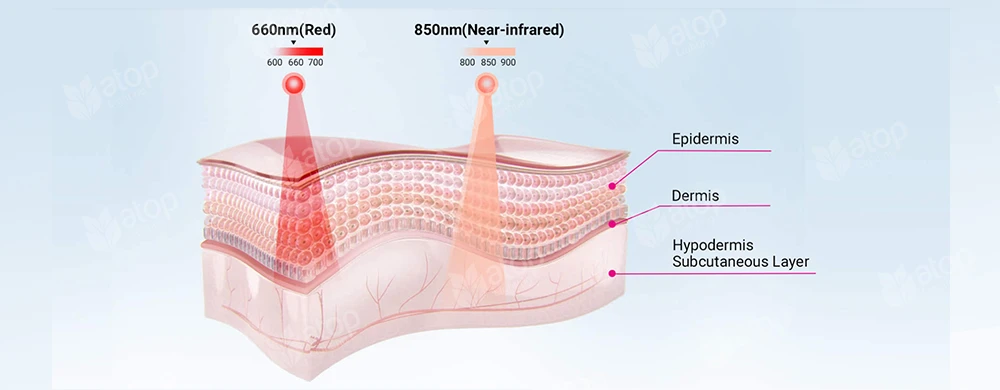The Benefits of 660nm Red Light for Health
Red light therapy is a powerful way to improve your overall health, rejuvenate your skin, and even boost your mood. The most commonly used and researched wavelengths in red light therapy are 660nm red light and 850nm infrared light.
When 660nm red light is applied to the skin, it penetrates deep into the tissues, where it’s absorbed by the mitochondria—the cell's “powerhouses.” This process boosts the production of adenosine triphosphate (ATP), the main energy source for cells, improving cellular function and vitality.
Today, we’ll focus on the remarkable benefits of 660nm red light and how it can positively impact your well-being.
What is 660nm red light
660nm red light is a specific wavelength within the red spectrum, part of the visible light range that humans can see. It can penetrate the skin to a depth of about 8-10 millimeters, reaching the dermal layer where it interacts with cells. Compared to 630nm wavelengths, 660nm light penetrates deeper into the skin and tissues. This makes it a popular choice in red light therapy due to its potential health and wellness benefits.
However, red light therapy (RLT) should not be used as a replacement for professional medical care in certain situations. It’s advisable to consult a healthcare professional for specific concerns or conditions.

Benefits of 660nm red light
660nm red light therapy offers numerous health and wellness benefits, including improved skin health, pain relief, reduced inflammation, accelerated athletic recovery and tissue repair, and support for hair growth.
Skin health benefits
660nm deep red light can promote collagen production, reduce wrinkles, and help treat conditions like acne and psoriasis.
A clinical trial found that LED therapy at 660nm is a safe and effective method for enhancing collagen. The study involved participants with aged or photoaged skin, half of whom received LED treatments while the other half received placebo treatments. Results showed that the LED-treated group experienced a 31% increase in collagen levels and an 18% decrease in MMP-1 levels, alongside reduced wrinkle depth, smoother skin texture, and a lower Fitzpatrick wrinkling severity score.
Additionally, another study demonstrated the effectiveness of combined blue (415nm) and red light (660nm) therapy for treating acne vulgaris without significant short-term side effects. In this study, 107 patients were divided into four groups: blue light, mixed blue and red light, cool white light, and 5% benzoyl peroxide cream. After 12 weeks of daily 15-minute treatments, the mixed blue and red light group showed the greatest improvement in inflammatory lesions, as well as notable improvements in comedones.
Plain relief and inflammation reduction
660nm red light can reduce inflammation and pain, which is beneficial for conditions like periodontitis, arthritis, and muscle soreness.
A case report demonstrated the use of a low-power laser (660nm) for soft tissue biomodulation during the clinical process of indirect composite resin restoration. This laser therapy was found to contribute positively to the final outcome by reducing gingival inflammation.
In a study, the effects of low-level laser therapy (LLLT) at 660nm were analyzed in rats with partial Achilles tendon injuries. The rats were divided into three groups and treated with either LLLT or a control treatment at various time points post-injury. The study found that LLLT significantly decreased the levels of inflammatory markers IL-1β and IL-6, while increasing the anti-inflammatory cytokine IL-10. These results suggest that LLLT at 660nm is an effective modulator of inflammatory responses in Achilles tendon injuries.
Athletic healing and tissue repair
660nm red light can stimulate the growth of new tissue and accelerate the healing process.
A study was conducted to assess the effectiveness of Low-Level Laser Therapy (LLLT) at 660nm in treating chronic wounds in patients with diabetic foot ulcers. Participants were randomly assigned to one of two groups: a control group and a treatment group receiving LLLT for four weeks. The results revealed that the group treated with LLLT showed significantly better tissue repair than the control group. The study concluded that LLLT is effective in promoting tissue regeneration and healing in chronic diabetic foot wounds.
Hair Growth
660nm red light can stimulate hair follicles, promoting hair growth and reducing hair loss.
A study was conducted to evaluate the effectiveness of photobiomodulation (PBM) at 660nm in treating androgenetic alopecia (AGA). Twenty-five men underwent PBM treatment over the course of 10 weeks. Hair density was measured using photographic evidence and analyzed with software. The results showed a significant increase in hair count after just 5 weeks of treatment, but no additional growth was observed after 10 weeks. The study concluded that while PBM is effective in stimulating hair growth in AGA, the benefits may level off after a certain period of treatment.
However, it's important to recognize the limitations of relying solely on 660nm light. Its penetration depth is still limited compared to near-infrared light, which means it is less effective at reaching deeper tissues, such as joints or muscles. For this reason, 660nm red light is often combined with 850nm infrared light for enhanced performance.
Disclaimer: This blog is for educational and entertainment purposes only and is not intended to be used for medical diagnosis, treatment, or prevention of any disease, illness, or health problem.

